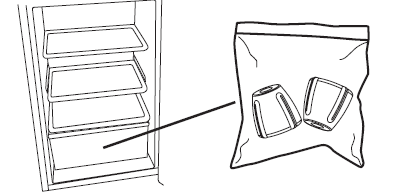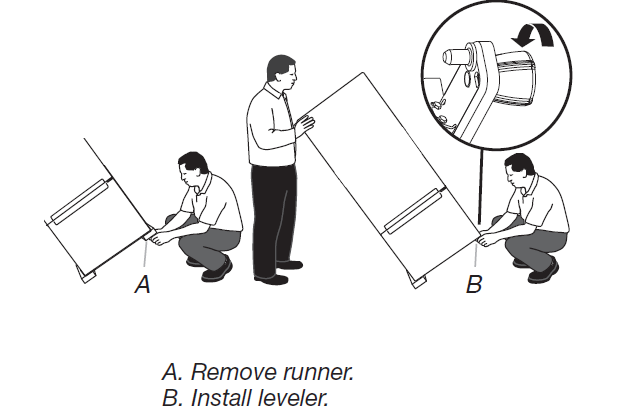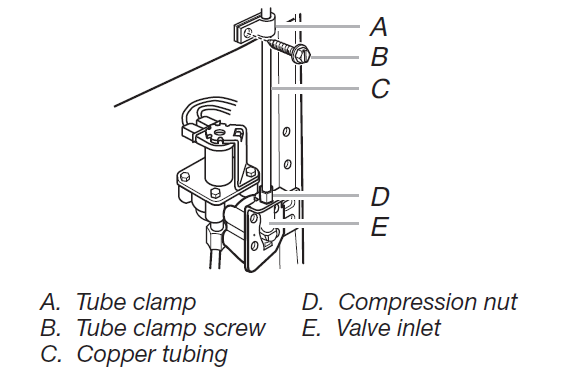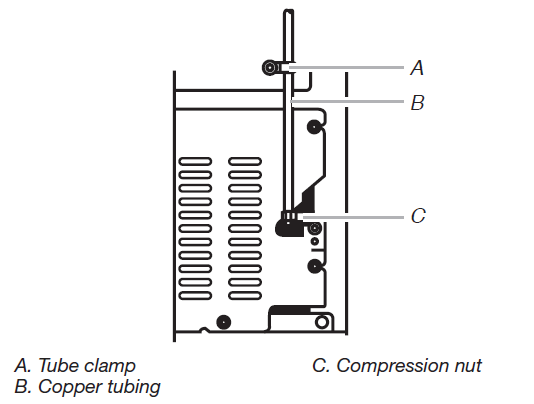Whirlpool Bottom Mount Refrigerator
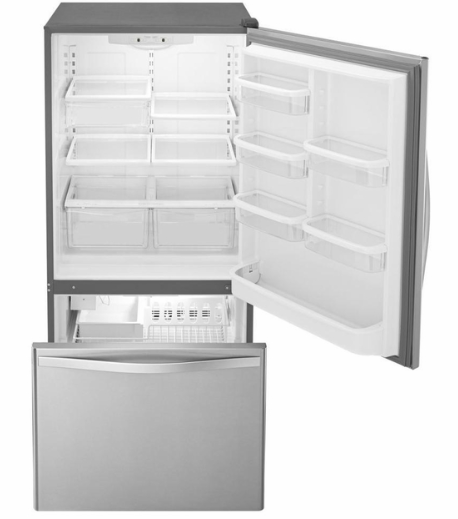
Learn MoreIn an effort to conserve natural resources, this refrigerator includes a condensed User Guide. A complete User Instructions manualcan be downloaded at: www.whirlpool.com/manuals. The model number is located on the inside wall of the refrigerator compartment.
In the U.S.A.:For assistance or service, call 1-800-253-1301.Register your refrigerator at www.whirlpool.com.
In Canada:For assistance or service, call 1-800-807-6777.Register your refrigerator at www.whirlpool.ca.
Your safety and the safety of others are very important.
We have provided many important safety messages in this manual and on your appliance. Always read and obey all safety messages. This is the safety alert symbol. This symbol alerts you to potential hazards that can kill or hurt you and others. All safety messages will follow the safety alert symbol and either the word “DANGER” or “WARNING.” These words mean:
DANGER: You can be killed or seriously injured if you don’t immediately follow instructions.WARNING: You can be killed or seriously injured if you don’t follow instructions.
All safety messages will tell you what the potential hazard is, tell you how to reduce the chance of injury, and tell you what can happen if the instructions are not followed.
IMPORTANT SAFETY INSTRUCTIONS
WARNING: To reduce the risk of fire, electric shock, or injury to persons when using your appliance, follow basic precautions, including the following:
- Children should be supervised to ensure that they do not play with the appliance.
- This appliance is not intended for use by persons (including children) with reduced physical, sensory, or mental capabilities, or lack of experience and knowledge, unless they have been given supervision or instruction concerning use of the appliance by a person responsible for their safety.
- Do not use an extension cord.
- If power supply cord is damaged, it must be replaced by the manufacturer, its service agent, or a similarly qualified person in order to avoid a hazard.
- Connect to potable water supply only.
- This appliance is intended to be used in household and similar applications such as: staff kitchen areas in shops, offices, and other working environments; farm houses and by clients in hotels, motels, and other residential-type environments; bed and breakfast-type environments; and catering and similar non-retail applications.
- Do not store explosive substances such as aerosol cans with a flammable propellant in this appliance.
- Do not use replacement parts that have not been recommended by the manufacturer (e.g., parts made at home using a 3D printer).
- Keep ventilation openings, in the appliance enclosure or in the built-in structure, clear of obstruction.
- Do not use mechanical devices or other means to accelerate the defrosting process, other than those recommended by the manufacturer.
- Do not damage the refrigerant circuit.
- Do not use electrical appliances inside the food storage compartments of the appliance, unless they are of the type recommended by the manufacturer.
- Ice maker kit can be added to some models. See serial tag inside the food compartment of appliance for ice maker kit model information.
- A qualified service technician must install the water line and ice maker. See installation instructions supplied with ice maker kit for complete details.
Proper Disposal of Your Old Refrigerator
WARNING: Risk of child entrapment. Before you throw away your old refrigerator or freezer:
- Take off the doors.
- Leave the shelves in place so that children may not easily climb inside.
WARNING Suffocation Hazard: Remove doors or lid from your old appliance. Failure to do so can result in death or brain damage.
IMPORTANT: Child entrapment and suffocation are not problems of the past. Junked or abandoned refrigerators are still dangerous, even if they will sit for “just a few days.”
If you are getting rid of your old refrigerator, please follow these instructions to help prevent accidents.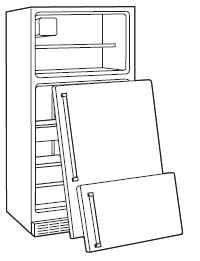
Important information to know about disposal of refrigerants:Dispose of refrigerator in accordance with federal and local regulations. Refrigerants must be evacuated by a licensed, EPA-certified refrigerant technician in accordance with established procedures.
INSTALLATION INSTRUCTIONS
Unpack the Refrigerator
- Remove tape and glue residue from surfaces before turning on the refrigerator. Rub a small amount of liquid dish soap over the adhesive with your fingers. Rinse with warm water and dry with a soft cloth.NOTE: Do not use sharp instruments, rubbing alcohol, flammable fluids, or abrasive cleaners to remove tape or glue. These products can damage the surface of your refrigerator. For more information see “Refrigerator Safety.”
When Moving Your Refrigerator:Your refrigerator is heavy. When moving the refrigerator for cleaning or service, be sure to cover the floor with cardboard or hardboard to avoid floor damage. Always pull the refrigerator straight out when moving it. Do not wiggle or “walk” the refrigerator when trying to move it, as floor damage could occur.
Electrical Requirements
Before you move your refrigerator into its final location, it is important to make sure you have the proper electrical connection. If the supply cord is damaged, it must be replaced by the manufacturer or its service agent or a similarly qualified person. Do not use a cord that shows cracks or abrasion damage along its length or at either the plug or connector end.
Recommended Grounding MethodA 115 V, 60 Hz, AC only, 15 A or 20 A fused, grounded electrical supply is required. It is recommended that a separate circuit serving only your refrigerator be provided. Use an outlet that cannot be turned off by a switch. Do not use an extension cord.
NOTE: Before performing any type of installation or cleaning, or removing a light bulb, turn cooling off or turn the control (Thermostat, Refrigerator or Freezer Control depending on the model) to OFF, and then disconnect the refrigerator from the electrical source. When you are finished, reconnect the refrigerator to the electrical source and turn cooling on or reset the control (Thermostat, Refrigerator or Freezer Control depending on the model) to the desired setting. See “Using the Controls” in the User Instructions, User Guide, or Use & Care Guide.
Install Levelers
IMPORTANT: Lay down the refrigerator ONLY to your left-hand side (as you are looking at the front of the refrigerator) to avoid damaging the refrigerator.
- Locate the levelers. They are enclosed in a plastic bag inside the crisper drawer.

- Using two or more people, access the bottom of the refrigerator either by tilting it first to one side and then the other or by laying it down on the floor to your left-hand side as shown.
- Tilt the refrigerator to the side enough to access the bottom. Using a 3/8″ hex driver, remove the two screws attaching the wooden runner to the bottom of the refrigerator. Then install a leveler to the front corner. Repeat for the opposite side.NOTE: The refrigerator cabinet should not touch the floor without a leveler installed.

- Using the packaging corner posts (left-hand side, front and back) as a cushion, lay the refrigerator down on the floor (to your left-hand side only) as shown in the following graphic.NOTE: Using the packaging as a cushion will help to avoid possible damage to the refrigerator.
- Using a 3/8″ hex driver, remove the two screws attaching each wooden runner to the bottom of the refrigerator. Install a leveler to each of the front corners.
- Tilt the refrigerator to the side enough to access the bottom. Using a 3/8″ hex driver, remove the two screws attaching the wooden runner to the bottom of the refrigerator. Then install a leveler to the front corner. Repeat for the opposite side.NOTE: The refrigerator cabinet should not touch the floor without a leveler installed.
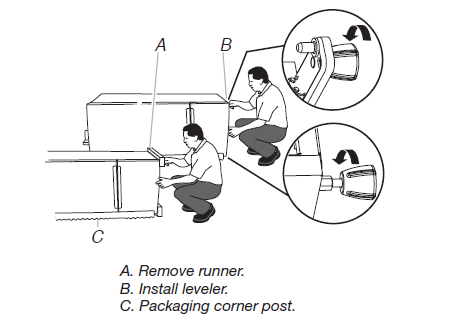
Clean Before UsingAfter you remove all of the package materials, clean the inside of your refrigerator before using it. See the cleaning instructions in “Refrigerator Care.”
Important information to know about glass shelves and covers:Do not clean glass shelves or covers with warm water when they are cold. Shelves and covers may break if exposed to sudden temperature changes or impact, such as bumping. Tempered glass is designed to shatter into many small, pebble-size pieces. This is normal. Glass shelves and covers are heavy. Use both hands when removing them to avoid dropping.
Location Requirements
IMPORTANT: This refrigerator is designed for indoor, household use only.
To ensure proper ventilation for your refrigerator, it is recommended to allow a 1/2″ (1.25 cm) space on each side. Allow 1½” (3.81 cm) of space between overhead cabinets and refrigerator top. Allow at least 1″ (2.54 cm) between back of cabinet and the wall (consider the condenser as back in case is present). If your refrigerator has an ice maker, make sure you leave extra space at the back for the water line connections. If you are installing your refrigerator next to a fixed wall, leave enough space on the hinge side to allow the door to swing open.
NOTE: This refrigerator is intended for use in a location where the temperature ranges from a minimum of 13°C (55°F) to a maximum of 43°C (110°F). The preferred room temperature range for optimum performance, which reduces electricity usage and provides superior cooling, is between 15°C (60°F) and 32°C (90°F). It is recommended that you do not install the refrigerator near a heat source, such as an oven or radiator.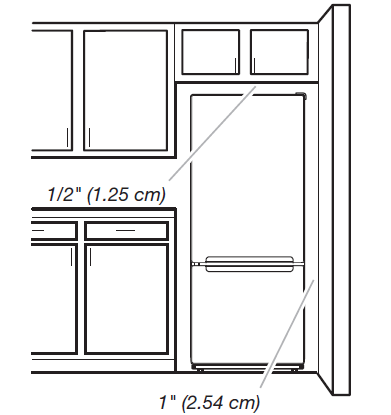
Water Supply Requirements
Read all directions before you begin.
IMPORTANT:
- Connect to potable water supply only.Do not use with water that is microbiologically unsafe or of unknown quality without adequate disinfection before or after the system. Systems certified for cyst reduction may be used on disinfected waters that may contain filterable cysts.
- If you turn the refrigerator on before the water line is connected, turn the ice maker off.
- All installations must meet local plumbing code requirements.
- Use copper tubing and check for leaks. Install copper tubing only in areas where the household temperatures will remain above freezing.
TOOLS NEEDED: Flat-blade screwdriver, 7/16″ and 1/2″ open-end wrenches or 2 adjustable wrenches, 1/4″ nut driver and drill bit, cordless drill. Gather the required tools and parts before starting installation. Read and follow the instructions provided with any tools listed.
NOTE: Your refrigerator dealer has a kit available with a 1/4″ (6.35 mm) saddle-type shutoff valve, a union, and copper tubing. Before purchasing, make sure a saddle-type valve complies with your local plumbing codes. Do not use a piercing-type or 3/16″ (4.76 mm) saddle valve which reduces water flow and clogs more easily.
Water PressureA cold water supply with water pressure between 30 psi and 120 psi (207 kPa and 827 kPa) is required to operate the ice maker. If you have questions about your water pressure, call a licensed, qualified plumber.
Reverse Osmosis Water SupplyIf a reverse osmosis water filtration system is connected to your cold water supply, the water pressure to the reverse osmosis system needs to be a minimum of 40 psi to 60 psi (276 kPa to 414 kPa). If the water pressure to the reverse osmosis system is less than 40 psi to 60 psi (276 kPa to 414 kPa), a booster pump can be inserted into the small tubing that goes from the cold water line to the reverse osmosis system.
If the ice maker is still not operating properly:
- Check to see whether the sediment filter in the reverse osmosis system is blocked. Replace the filter if necessary.
- Allow the storage tank on the reverse osmosis system to refill after heavy usage. If you have questions about your water pressure, call a licensed, qualified plumber.
Connect the Water Supply (on some models)
Read all directions before you begin.
IMPORTANT: If you turn the refrigerator on before the water line is connected, turn the ice maker off to avoid excessive noise or damage to the water valve.
Connect the Water Line
- Unplug refrigerator or disconnect power.
- Turn off main water supply. Turn on nearest faucet long enough to clear line of water.
- Locate a 1/2″ to 1¼” (1.27 cm to 3.18 cm) vertical cold water pipe near the refrigerator.IMPORTANT:Make sure it is a cold water pipe.Horizontal pipe will work. Drill on the top side of the pipe, not the bottom. This will help keep water away from the drill and normal sediment from collecting in the valve.
- Determine the length of copper tubing you will need. Measure from the connection on lower left rear of refrigerator to the water pipe. Add 7 ft (2.1 m) to allow for cleaning. Use 1/4″ (6.35 mm) O.D. (outside diameter) copper tubing. Be sure both ends of copper tubing are cut square.
- Using a cordless drill, drill a 1/4″ (6.35 mm) hole in the cold water pipe you have selected.

- Fasten the shutoff valve to the cold water pipe with the pipe clamp. Be sure the outlet end is solidly in the 1/4″ (6.35 mm)drilled hole in the water pipe and that the washer is under the pipe clamp. Tighten the packing nut. Tighten the pipe clamp screws slowly and evenly so washer makes a water tight seal. Do not overtighten.
- Slip the compression sleeve and compression nut on the copper tubing as shown. Insert the end of the tubing into the outlet end squarely as far as it will go. Screw compression nut onto outlet end with adjustable wrench. Do not overtighten.
- Place the free end of the copper tubing in a container or sink, and turn on the main water supply. Flush the tubing until water is clear. Turn off the shutoff valve on the water pipe. Coil the copper tubing.
Connect to Refrigerator
NOTE: On kit models, attach water valve to refrigerator according to kit instructions.
Style 1
- Unplug refrigerator or disconnect power.
- Attach the copper tube to the valve inlet using a compression nut and sleeve as shown. Tighten the compression nut. Do not overtighten.
- Use the tube clamp on the back of the refrigerator to secure the tubing to the refrigerator as shown. This will help avoid damage to the tubing when the refrigerator is pushed back against the wall.
- Turn shutoff valve ON.
- Check for leaks. Tighten any connections (including connections at the valve) or nuts that leak.

- The ice maker is equipped with a built-in water strainer. If your water conditions require a second water strainer, install it in the 1/4″ (6.35 mm) water line at either tube connection. Obtain a water strainer from your nearest appliance dealer.
Style 2
- Unplug refrigerator or disconnect power.
- Disconnect the tube clamp on the back of the product and insert the copper tubing through the clamp as shown.
- Attach the copper tube to the valve inlet using a compression nut and sleeve as shown.
- Tighten the compression nut. Do not overtighten. Reattach the tube clamp and tube to the back of the cabinet.

- Turn shutoff valve ON. Check for leaks. Tighten any connections (including connections at the valve) or nuts that leak.
- The ice maker is equipped with a built-in water strainer. If your water conditions require a second water strainer, install it in the 1/4″ (6.35 mm) water line at either tube connection. Obtain a water strainer from your nearest appliance dealer.
Complete the Installation
- Plug into a grounded 3 prong outlet.NOTE: Allow 24 hours to produce the first batch of ice. Discard the first three batches of ice produced. Allow 3 days to completely fill ice container.
TOOLS NEEDED: 5/16″ hex-head socket wrench, #2 Phillips screwdriver, flat-blade screwdriver, 5/16″ open-end wrench, flat 2″ putty knife.
IMPORTANT:
- Before you begin, turn off the refrigerator control. Unplug refrigerator or disconnect power.
- Remove food and adjustable door or utility bins from doors.
- If you are only removing and replacing the doors, see the “Remove Doors and Hinges” and “Replace Doors and Hinges” sections.
Remove Doors and Hinges
- Unplug refrigerator or disconnect power.
- Close the refrigerator door and keep both doors closed until you are ready to lift them free from the cabinet.NOTE: Provide support between the freezer and refrigerator doors while the hinges are being moved. Do not depend on the door magnets to hold the doors in place while you are working.
- Remove the parts for the top hinge as shown in Top Hinge graphic. Lift the freezer door free from the cabinet.
- Remove the parts for the center hinge as shown in the Center Hinge graphic.NOTE: Provide support between the refrigerator door and the floor while the hinges are being moved. Do not depend on the door magnets to hold the door in place while you are working.
- Lift the refrigerator door free from the cabinet.
- Remove the four screws, (two on the bottom and two on the front) attaching the bottom hinge to the cabinet. See Bottom Hinge graphic.
Reverse Doors (optional)
IMPORTANT: If you want to reverse your doors so that they open in the opposite direction, follow these steps. If you are not reversing the doors, see “Replace Doors and Hinges.” Graphics follow these instructions.
Cabinet
- From the top of the cabinet, remove the hinge caps, move them to the opposite side, and insert the hinge caps into the holes from where you removed the hinge screws. See Graphic 1-2.
- Remove the screws filling the holes to be used for the center hinge and install them on the opposite side.
- Move the leveler from the bottom of the refrigerator and install it on the opposite side.
- Move the parts of the top hinge, center hinge and bottom hinge to the opposite side.
Doors
- Remove door hinge hole plug from top of freezer door. Move to opposite side as shown. See Graphic 2.
- Remove the door stop from the bottoms of both the freezer and refrigerator doors and install them on the opposite side. See Graphics 3 and 4.
Replace Doors and Hinges
NOTES:
- Door Removal & Replacement and Door Swing Reversal graphics may be reversed if door swing is reversed.
- Provide additional support for the doors while the hinges are being reinstalled. Do not depend on the door magnets to hold the doors in place while you are working.
- Replace the parts for the bottom hinge as shown. Tighten screws. Replace the refrigerator door.
- Assemble the parts for the center hinge as shown and tighten all screws. See Center Hinge graphic. Replace the freezer door.
- Assemble the parts for the top hinge as shown. See Top Hinge graphic. Do not tighten screws completely.
- Align the doors so that the bottom of the freezer door is even with the top of the refrigerator door. Tighten all screws.
Final Steps
- Check all holes to make sure that hinge caps and screws are in place.
- Plug into a grounded 3 prong outlet.
- Reset the controls. See “Using the Control(s)” in the User Instructions, User Guide, or Use & Care Guide.
- Return all removable door parts to doors and food to refrigerator.
WARNINGElectrical Shock HazardDisconnect power before removing doors. Failure to do so can result in death or electrical shock.
Leveling and Door Adjustment
Your refrigerator has two adjustable levelers, one on each side, at the base of the refrigerator. If your refrigerator seems unsteady or if you want the doors to close more easily, adjust the level and tilt of the refrigerator.
- Turn the leveler to the left to raise that side of the refrigerator or to the right to lower that side. It may take several turns to level the refrigerator.NOTE: Having someone push against the top of the refrigerator takes some weight off the levelers. This makes it easier to turn the levelers.
- Once the refrigerator is level from side to side, raise the front levelers so that the refrigerator is tilted slightly (approximately 1/2″) downward to the rear. The doors will close more easily and the freezer door will remain closed whenever you close the refrigerator door.
- Open both doors again to make sure that they close as easily as you like. If not, tilt the refrigerator slightly more to the rear by turning both levelers to the right. It may take several more turns.NOTE: To keep the refrigerator level, make the same adjustment to each side.
- Using a level, make sure the refrigerator is still level from side to side. Readjust if necessary.
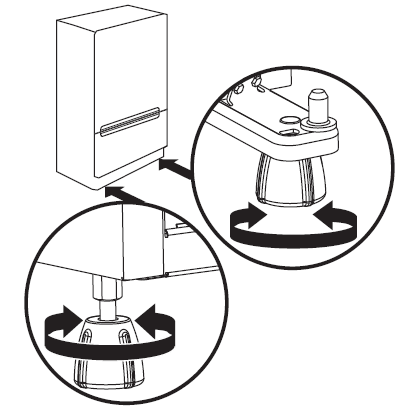
Normal SoundsYour new refrigerator may make sounds that your old one didn’t make. Because the sounds are new to you, you might be concerned about them. Most of the new sounds are normal. Hard surfaces, such as the floor, walls, and cabinets, can make the sounds seem louder. The following describes the kinds of sounds and what may be making them.
- If your refrigerator is equipped with an ice maker, you will hear a buzzing sound when the water valve opens to fill the ice maker for each cycle.
- Your refrigerator is designed to run more efficiently to keep your food items at the desired temperatures and to minimize energy usage. The high efficiency compressor and fans may cause your refrigerator to run longer than your old one. You may also hear a pulsating or high-pitched sound from the compressor or fans adjusting to optimize performance.
- You may hear the evaporator fan motor circulating air through the refrigerator and freezer compartments. The fan speed may increase as you open the doors or add warm food.
- Rattling noises may come from the flow of refrigerant, the water line, or items stored on top of the refrigerator.
- Water dripping on the defrost heater during a defrost cycle may cause a sizzling sound.
- As each cycle ends, you may hear a gurgling sound due to the refrigerant flowing in your refrigerator.
- Contraction and expansion of the inside walls may cause a popping noise.
- You may hear air being forced over the condenser by the condenser fan.
- You may hear water running into the drain pan during the defrost cycle.
REFRIGERATOR USE
Ensuring Proper Air CirculationIn order to ensure proper temperatures, you need to permit airflow between the refrigerator and freezer sections. As shown in the illustration, cool air enters through the bottom of the freezer section and moves up. Most of the air then flows through the freezer section vents and recirculates under the freezer floor. The rest of the air enters the refrigerator section through the top vent.NOTE: Depending on your model, the refrigerator may have either a Normal flow or Multiflow air system.

Do not block any of these vents with food packages. If the vents are blocked, airflow will be restricted and temperature and moisture problems may occur.IMPORTANT: Because air circulates between both sections, any odors formed in one section will transfer to the other. You must thoroughly clean both sections to eliminate odors. To avoid odor transfer and drying out of food, wrap or cover foods tightly.
OPERATING YOUR REFRIGERATOR
How to use the refrigerator with electronic control (some models)
Your refrigerator is equipped with a cutting-edge and user-friendly electronic temperature control located on the front panel of the refrigerator door.

Fridge Temp and Freezer Temp Refrigerator: 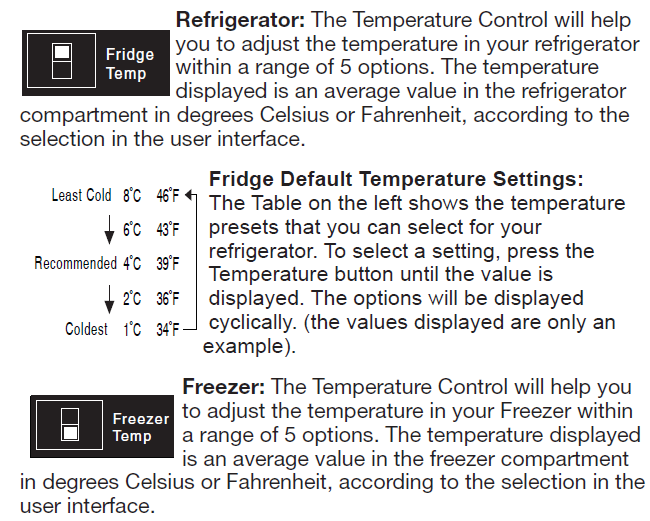
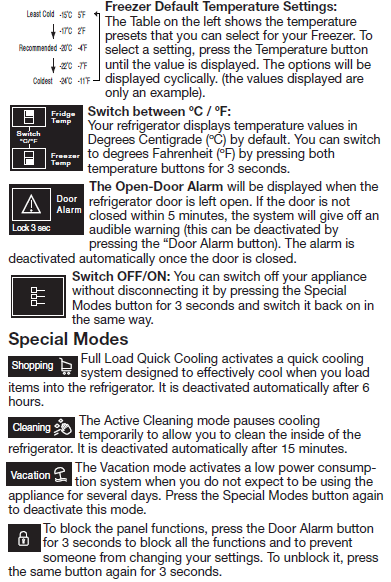
Auto-Hibernate
Hibernating: Your product can deliver optimal performance when you are not at home. For this purpose, use the Hibernating function to set the appliance to energy optimizing mode while you are not using it. Press the Cooling Modes button for 3 seconds to enter this mode and improve the appliance’s performance for as long as you wish. To exit this mode, press the same button again for 3 seconds.
COOLING MODE
Fast Cool: Use Quick Cooling in the freezer to make ice faster or freeze your food or drinks for longer. (Some Models)Fast Ice: Full Load Quick Cooling activates a quick cooling system of all content and can be used for parties or meetings. This quick cooling system is available at all times.Fast Drink: Quick Drink Cooling activates a quick cooling system to cool a drink for immediate use (bottle or can). To use this function, place the drink inside the freezer drawers. Once the cooling time ends, an alarm will go off to tell you that you can remove and enjoy your drink. It is deactivated automatically after 30 minutes.Crisper Humidity Control (on some models)You control the amount of humidity in the moisture-sealed crisper. Depending on the produce you are storing, select the desired Humidity Level.
Humidity Level – Min Setting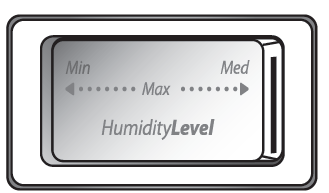
MIN (open) lets moist air out of the crisper for best storage of fruits and vegetables with skins.
- Fruit: Wash, let dry and store in refrigerator in plastic bag or crisper. Do not wash or cut berries until they are ready to use. Sort and keep berries in original container in crisper, or store in a loosely closed paper bag on a refrigerator shelf.
- Vegetables with skins: Place in plastic bag or plastic container and store in crisper.Humidity Level – Max SettingMAX (closed) keeps moist air in the crisper for best storage of fresh, leafy vegetables.
- Leafy vegetables: Wash in cold water, drain and trim or tear off bruised and discolored areas. Place in plastic bag or plastic container and store in crisper.
ICE AND WATER
Ice Maker (on some models – Accessory)
- Allow 24 hours to produce the first batch of ice. Discard the first three batches of ice produced.
- The quality of your ice will be only as good as the quality of the water supplied to your ice maker. Avoid connecting the ice maker to a softened water supply. Water softener chemicals such as salt) can damage parts of the ice maker and lead to poor quality ice. If a softened water supply cannot be avoided, make sure the water softener is operating properly and is well maintained.
- Do not use anything sharp to break up the ice in the storage bin. This can cause damage to the ice container and the dispenser mechanism.
- Do not store anything on top of or in the ice maker or storage bin.
Turning the Ice Maker On/OffThe On/Off switch is located on the bottom of the Ice Maker, can be accessed by lifting and opening the ice maker door.

- To turn on the ice maker, lift open the ice maker door, flip the switch to the On (right) position.
- To manually turn off the ice maker, lift open the ice maker door, flip, the switch to the Off (left) position. Ice can still be dispensed, but no more can be made.NOTE: Your ice maker has an automatic shutoff to keep the storage bin from overfilling during normal operation. As ice is made, the ice cubes will fill the ice storage bin, and the ice cubes will raise the shutoff arm to the Off (arm up) position. When the storage bin is at full capacity, the ice maker will automatically stop ice production, but the ice maker On/Off switch will remain in the On position.
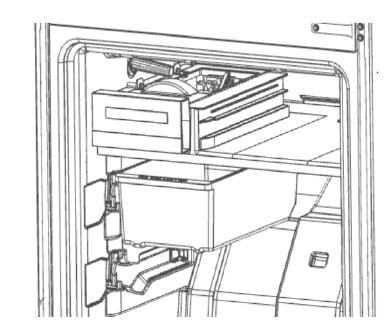
REFRIGERATOR CARE
Cleaning:Both the refrigerator and freezer sections defrost automatically. However, clean both sections about once a month to avoid build up of odors. Wipe up spills immediately.
IMPORTANT: Because air circulates between both sections, any odors formed in one section will transfer to the other. You must thoroughly clean both sections to eliminate odors. To avoid odor transfer and drying out of food, wrap or cover foods tightly.
To Clean Your Refrigerator:
NOTE: Do not use abrasive or harsh cleaners such as window sprays, scouring cleansers, flammable fluids, cleaning waxes, concentrated detergents, bleaches or cleansers containing petroleum products on plastic parts, interior and door liners or gaskets. Do not use paper towels, scouring pads, or other harsh cleaning tools.
- Unplug refrigerator or disconnect power.
- Hand wash, rinse, and dry removable parts and interior surfaces thoroughly. Use a clean sponge or soft cloth and a mild detergent in warm water.
- Wash painted metal exteriors with a clean sponge or soft cloth and a mild detergent in warm water. Dry thoroughly with a soft cloth.
- Plug in refrigerator or reconnect power.
Condenser Cleaning
There is no need for routine condenser cleaning in normal home operating environments. If the environment is particularly greasy or dusty or there is significant pet traffic in the home, the condenser should be cleaned every 6 months to ensure maximum efficiency.
- Unplug refrigerator or disconnect power.
- Remove the base grille.
- Use a vacuum cleaner with a soft brush to clean the grille, the open areas behind the grille, and the front surface area of the condenser.
- Replace the base grille when finished.
- Plug in refrigerator or reconnect power.NOTE: If you are unable to clean the condenser, please call for service.
VacationIf you installed an ice maker and connected it to your household water line, turn off the water supply to the refrigerator if you will be away from home for longer than a few days.
ACCESSORIES
The following accessories are available for your refrigerator. To order, contact us and ask for the Part Number.
In the U.S.A., visit our webpage: www.whirlpool.com/accessories or call 1-800-901-2042.In Canada, call 1-800-807-6777.
Automatic Ice Maker Kit (in some models):Order Part #W11416493Affresh® Kitchen & Appliance Cleaner:Order Part #W10355010
PROBLEM SOLVER
First try the solutions suggested here. If you need further assistance or more recommendations that may help you avoid a service call, refer to the warranty page in this manual and scan the code there with your mobile device, or visit www.whirlpool.com/product_help. In Canada, visit http://www.whirlpool.ca.
| If you experience | Possible Causes and/or Recommended Solutions |
| The refrigerator will not operate | ■ Not connected to an electrical supply – Plug the power cord into a grounded 3-prong outlet. Do not use an extension cord.
■ No power to the electrical outlet – Plug in a lamp to see if the outlet is working. ■ Household fuse blown or circuit breaker tripped – Replace the fuse or reset the circuit breaker. If the problem continues, contact an electrician. ■ Control is not turned on – Turn on the refrigerator control. See “Using the Controls.” ■ New Installation – Allow 24 hours following installation for the refrigerator to cool completely. NOTE: Adjusting the temperature controls to coldest setting will not cool the refrigerator more quickly. |
| The motor seems to run too much | Your new refrigerator may run longer than your old one. Energy efficient refrigerators run longer at lower, more energy efficient speeds. Your refrigerator may run even longer if the room is warm, a large food load is added, the door is opened often, or if the door has been left open. |
| The refrigerator is noisy | Refrigerator noise has been reduced over the years. Due to this reduction in operating noise, you may notice unfamiliar noises that are normal. Following are some normal sounds with an explanation:
■ Buzzing – heard when the water valve opens to fill the ice maker ■ Clicking/Snapping – valves opening or closing ■ Pulsating – fans/compressor adjusting to optimize performance ■ Rattling – flow of refrigerant, water line, or from items placed on top of the refrigerator ■ Sizzling/Gurgling – water dripping on the heater during defrost cycle ■ Popping – contraction/expansion of inside walls, especially during initial cool-down ■ Water running – may be heard when ice melts during the defrost cycle and water runs into the drain pan ■ Creaking/Cracking – occurs as ice is being ejected from the ice maker mold. |
| The door will not close completely | ■ The door is blocked open – Move food packages away from door. Push bin or shelf back in the correct position. Make sure the crisper cover is fully pushed in, so that the back rests on the supports. |
| The door is difficult to open | ■ Gaskets are dirty or sticky – Clean gaskets and contact surfaces with mild soap and warm water. Rinse and dry with soft cloth. |
| Temperature is too warm | ■ New Installation – Allow 24 hours following installation for the refrigerator to cool completely.
■ Door(s) opened often or not closed completely – Allows warm air to enter refrigerator. Minimize door openings and keep doors fully closed. ■ A large amount of warm food has been recently added – Allow several hours for refrigerator to return to normal temperature. ■ Check that the Temperature Control(s) are set correctly for the surrounding conditions – Adjust the controls to one setting colder. Check temperature in 24 hours. See “Using the Controls.” |
| There is interior moisture buildup
NOTE: Some moisture buildup is normal. |
■ Humid room – Contributes to moisture buildup in the refrigerator.
■ Door(s) opened often or not closed completely – Allows humid air to enter the refrigerator. Minimize door openings and keep door fully closed. |
| The ice maker is not
producing ice or not enough ice |
■ The ice maker is not connected to a water supply – Connect refrigerator to water supply and turn water shutoff valve fully open.
■ A kink in the line can reduce water flow – Straighten the water source line. ■ Ice maker is not turned on – Make sure the ice maker wire shutoff arm or switch (depending on model) is in the ON position. ■ New installation – Wait 24 hours after ice maker installation for ice production to begin. Wait 3 days for full ice production. ■ Large amount of ice recently removed – Allow sufficient time or ice maker to produce more ice. ■ Ice cube jammed in the ice maker ejector arm – Remove ice from the ejector arm with a plastic utensil. ■ A reverse osmosis water filtration system connected to our cold water supply can decrease water pressure – See “Water Supply Requirements.” |
| The ice cubes are hollow or small
NOTE: This is an indication of low water pressure. |
■ The water valve is not completely open – Completely open the water shutoff valve.
■ A kink in the line can reduce water flow – Straighten the water source line. ■ A reverse osmosis water filtration system connected to our cold water supply can decrease water pressure – See “Water Supply Requirements.” ■ If questions regarding water pressure remain, call a licensed, qualified plumber. |
| Off-taste, odor or gray color in the ice | ■ New plumbing connections can cause discolored or off-flavored ice – Discard the ice and wash the ice storage bin. Allow 24 hours for the ice maker to make new ice, and discard the first 3 batches of ice produced
■ Ice stored too long can develop an off-taste – Discard ice. Wash ice bin. Allow 24 hours for ice maker to make new ice. ■ Food odor transferring to ice – Use airtight, moisture proof packaging to store food. ■ There are minerals (such as sulfur) in the water – A water filter my need to be installed to remove the minerals. |
References
[xyz-ips snippet=”download-snippet”]



